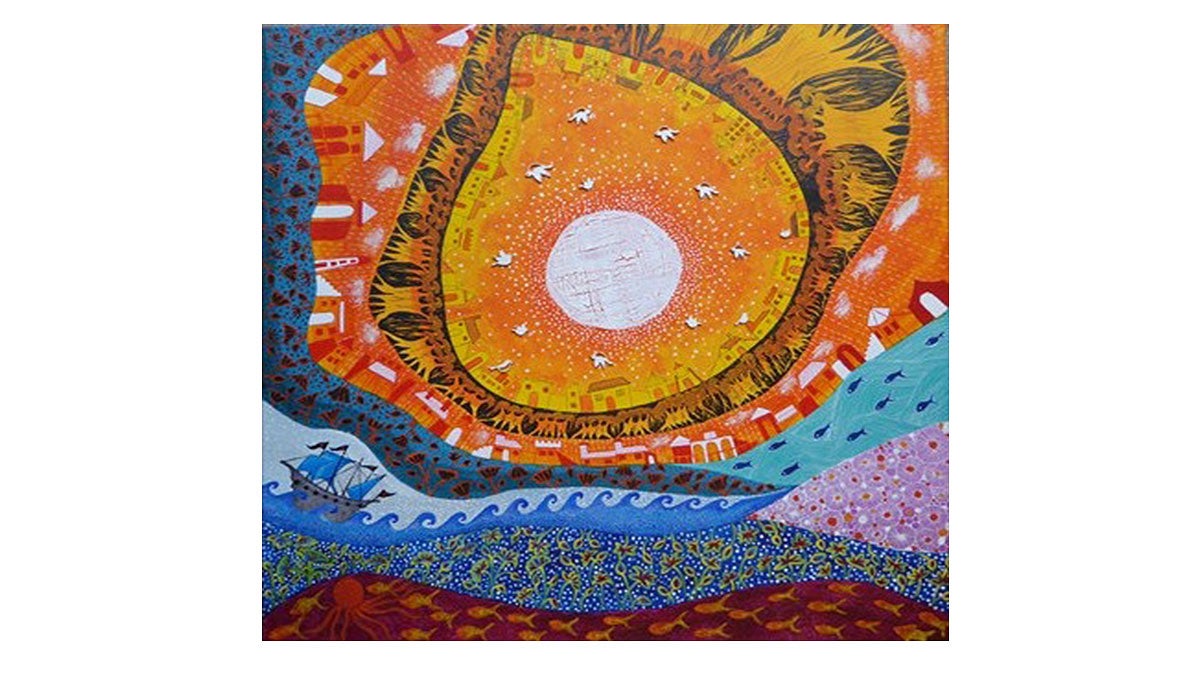Using the visual arts to show the multiple interpretations of Dharma

Saran Anusha Srishti
Dharma is a complex concept of central importance in Indian philosophy and religion, with multiple meanings in Hinduism, Buddhism, Jainism and Sikhism. Rather than explain it with words, artists of the Indian diaspora interpret Dharma in the 21st Century in the media they best express themselves in, on view at the West Windsor Arts Center through July 1. Through the sale of artwork, organizers hope to raise funds to support the Clean Ganga Fund, an Indian national effort to save the endangered holy river.
The Ganga, or Ganges, is worshipped as a goddess. Hindus bathe in its waters, paying homage to their ancestors and to their gods by cupping the water in their hands, lifting it and letting it fall back into the river. They offer flowers and rose petals and float shallow clay dishes filled with oil and lit with wicks (diyas). On the journey back home from the Ganges, they carry small quantities of river water with them for use in rituals, and when a loved one dies, their ashes are brought to the river. Because of human, industrial and ceremonial religious waste, the Ganges is one of the most polluted rivers in the world.
“Gandhi lived on the principles of Dharma,” says exhibition curator and artist Hetal Mistry, who recently made a trip to her native land, visiting the oldest living city of Varansi through which the Ganga flows. “It’s not easy to get to, but everyone wants to go once in a lifetime,” she says. The trip was a surprise gift from her husband to celebrate a big birthday. They took the Maharaja Express, which Mistry describes as being like a cruise on a train, from Delhi to seven other cities, including Varansi. She witnessed the evening prayers on the banks of the river that have been performed for thousands of years, with masses of people gathered on boats and on the banks. Though traditional to bathe in the water, “it was not easy with all the people” so they filled an empty bottle and sprinkled it on their heads. “It was very touching to see the worshipping on the river. It was a life-changing moment and I had to do something when I got back.” The exhibit on Dharma came to her, with the goal of doing something to benefit the river’s cleanup effort.
For Mistry, in Dharma are the values she seeks to live by: truth, compassion, purity. “If we have these values, our lives can be different. People are into social media and getting more information, but we’re losing these values. This is about bringing these values back. The truth is the sun rises every morning, it never forgets. As human beings we have to have that conviction that we learn from the sun or the moonrise.”
Part of Dharma is meditation. “We judge people by outward appearance but we need to look inside ourselves. Compassion—we must do good for others not to get something in return, but just to do good. Purity, like the lotus flower, grows from the mud. If you are pure you can help other people.”
Born in Gujarat and raised in Mumbai, Hetal was 22 when she came to the U.S. to marry. Her had grown up in New Jersey, but their parents knew one another and it was the typical “we have a girl, they have a boy, let’s see if they like each other,” says Mistry. The young couple exchanged letters and calls and met for the first time when he was visiting grandparents in India. She was 19 when they began a two-year engagement, then started the paperwork to immigrate.
Working as an illustrator, doing cell animation for international TV commercials in India, she became a graphic designer for Princeton Theological Seminary once in the U.S., and had a solo exhibit at the school’s Erdman Gallery in 2008. She went on to have shows in Lambertville and New Hope, and in 2011, when her second son was 2, she rolled her canvases in a tube and carried them on a flight to India for a show.
One of Mistry’s paintings in Dharma in the 21st Century shows a woman lighting a lamp. “In the evening in Varansi, there is a peacefulness, with blues and greens. You can see buildings along the water and twinkling lights from windows,” she says. “There are people in small boats, and it is tradition to light a lamp and leave it in the river with a few flowers. In Indian tradition, when you pray you light a lamp to remind yourself of all the good things out there to connect you to a higher power, and to see inside.”
WHYY is your source for fact-based, in-depth journalism and information. As a nonprofit organization, we rely on financial support from readers like you. Please give today.





